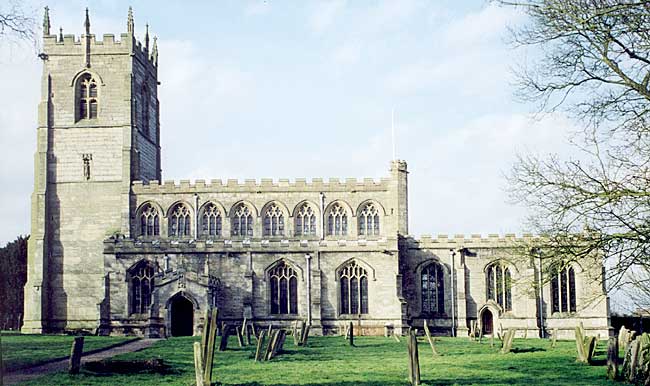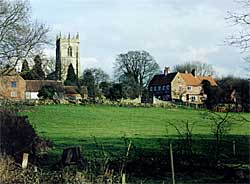East Markham
TWO Notts, villages bear the name of Markham, one being East or Great and the other West or Little Markham. Distinct parishes, situated more than a mile apart, they lie on either side of the Great North Road and the former includes Markham Moor within its boundaries.

East Markham church (photo: A. Nicholson, 2001).
This sketch is concerned with East Markham, and its annals are plenteous and colourful. The history of the family that bears the village name is voluminous. For centuries they, were lords of the vill and they figured in national as well as local history,) providing an archbishop, eminent judges and soldiers, courtiers, a duelist and a traitor.
Volumes have been written about them, the earliest in 1601, the latest in two well-filled tomes by the distinguished geographer, Sir Clements R. Markham, who selected Capt. Scott as the leader of the famous Antarctic expedition in the early years of this century.
But apart from this family the parish has a story worth reading. Its name, a compound of the old English 'meare,' a boundary, and 'ham,' a home, argues, Saxon origin. A suggestion has been made that, the boundary in question may relate to Mercian times some 11 centuries ago and that its founders were the tribe of Angles called Gainas who gave their name to Gainsborough. For two centuries prior to 1066 it was largely peopled by Danes who amalgamated with the Saxon race, and under them the village thrived and grew populous. At the Norman Conquest its old owners, Frane. Ulchel, Godwin and Edwi, were dispossessed of their manors.
King William allotted a goodly part to himself as soc to his manor of Dunham, with land for 10 ploughs, 25 socmen, 15 villeins, and there was a church with a priest, a mill, much meadow and land already under cultivation.
Most of the rest of the soil went to swell the enormous grant to Roger de Busli, who instituted Fulc de Lisures (the name is variously spelt) and his brother Turold, with one Goisfrid, as his "men" or tenants, here: They: were men of substance, Fulc holding also at nine other Notts, villages, Turold also at Hodsock, Kelham and Weston, and Goisfrid at Cuckney. Ulchel was allowed to retain as tenant the land which had been his own, and Sir Clements Markham suggests that Fulc may have obtained his interests here by marrying Ulchel's heiress. Judging from the data given in Domesday the population would appear to have been not less than 250 in 1087.
Upon the death of de Busli in 1098, the infamous Robert Belleme seized Roger's great fee of Blyth, ignoring the claims of the Busli heirs, and so became the overlord of E. Markham. His rapacity was equalled only by his cruelty; he is reputed to have preferred to torture captives rather than permit them to be ransomed; nothing afforded him greater pleasure than to witness them writhing in. agony while being roasted to death before a slow fire.
East Markham was a pawn in a church squabble
In the 12th century the portion of Turold de Lysieux, at East Markham passed to Roger de Cressi of Hodsock, and under Henry II the Markhams emerged. Sir Alexander de Marcham (who may have been a son of Fule de Lysieux) was appointed constable ot Nottingham Castle by that king. In 1191 the future King John, then Earl of Mortain, gave Markham Church as part of the Chapelry of Blyth to the Church of St. Mary at Rouen.
The monastic share of the parish was small and limited to the priory at Blyth which Roger de Busli had founded. In 1110 Fule de Lysieux gave it a toft and croft with a parcel of land and later Rd. de Marcham bestowed upon it 20s. a year. Avicia de Chevercourt gave some 15s. of land "for the refection of the monks on the anniversary of her death, that by their intercession her soul in heaven might have refection with celestial meat and drink." It was a benefaction which would be duly observed by them.
CASTLE GUARD.
By 1242 the Saundbys and Tyllys were holding local property from the Countess of Eu to whom much of the Busii fee had descended, and 15 years later the living was reduced to a vicarage, provision being made for a vicar who was to be familiar with the English language (at a time when Italian priests occupied so many benefices) and to have part of the rectory mansion for his parsonage.
The arrangement seems to have been designed to take effect upon the death of the priest then in office, but he lingered until 1293. Old age then compelled him to resign and a compassionate allowance of a share of the great tithes of Tuxford which pertained to E. Markham church were granted him for the rest of his life.
The Lady Philippa de Tylly died in 1247, holding a knight's fee at Upton and E. Markham of the Countess of Eu, but as her children stayed in Normandy these lands reverted to the Crown, Henry III granting the Tickhill (Blyth) Honour to his son Edmund who passed these properties to Aymo de Tromberge who for his lands had to do castle-guard at Tickhill and make a length of the causeway there.
STRUGGLE FOR THE CHURCH.

East Markham church and the Old Hall.
The grasping Italian ecclesiastic Boniface de Saluzzo (or Saluciis) who claimed kinship with Edward I, attempted to seize this among other benefices and for several years the parishioners scarcely knew who was their vicar.
The Archbishop of York thundered against the interloper and bade the inhabitants not to obey him, but Boniface must have had the king's support for it was not until after the accession of Edward II in 1307 that the intruder was displaced.
The vicar who died in 1349 may have been one of the local victims of the Black Death, and mention of Robt. le Webbester about this time suggests that the Flemish art of weaving was being practised here. There was then a market in the village and a market cross on a mound near the church, of which no trace remains. The Founs had established themselves, one being a knight of the shire, and under Richard II the Willoughbys owned part of the parish. In that reign, the Lynhams parted with their share of the will to Judge Markham—a farmhouse with a large cellar being, it is thought the site of their home.
Nottinghamshire judge whose integrity bred a legend
THE Sir John Markham who increased his estate by espousing the Cressy heiress and was lord of the vill at the close of the 14th century was of considerable eminence.
It was he who drew up the legal document for the deposition of Richard II in 1399, and he was one of the commissioners who received the crown for Henry IV. In 1396 he became a judge, and, according to tradition immortalised by Shakespeare in Henry IV part two, he committed Prince Henry (later Henry V) to prison for contempt of court.
